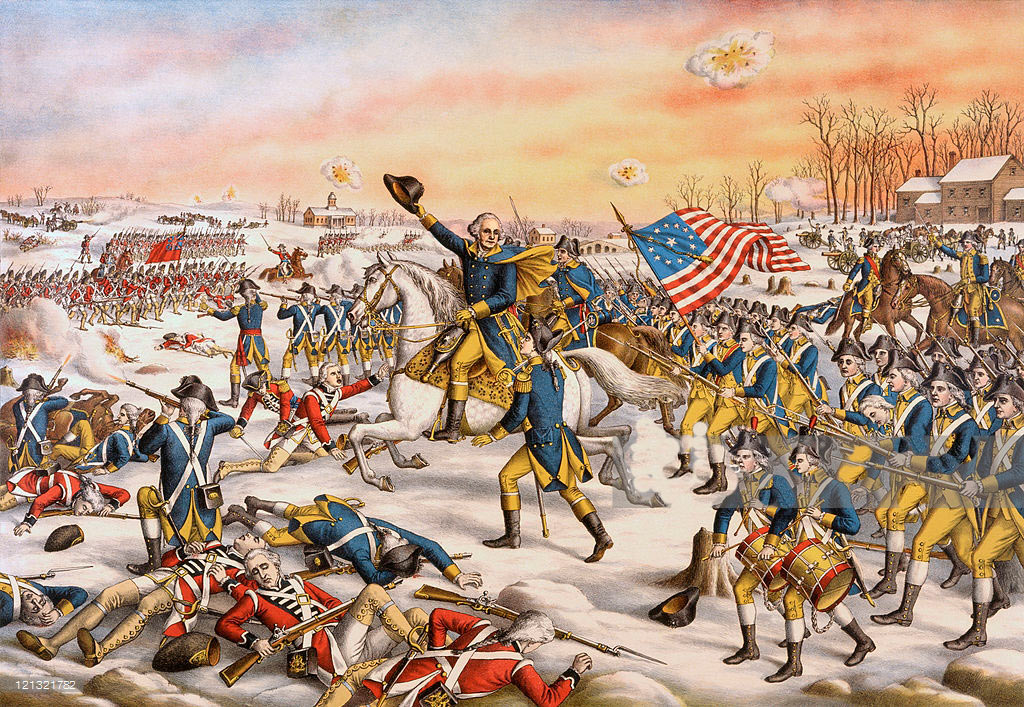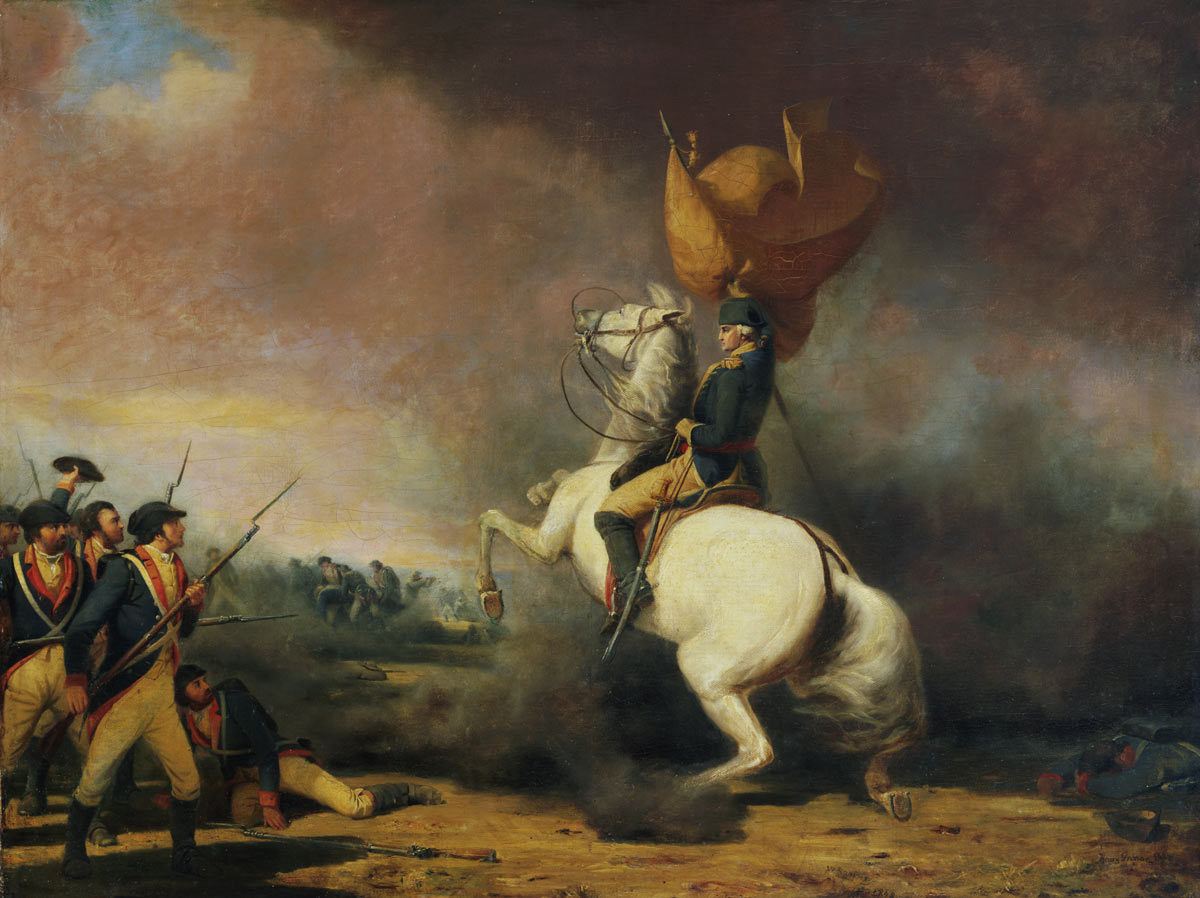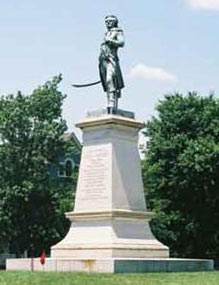The sequel on 3rd January 1777 to the successful Battle of Trenton: the two battles began the resurgence of the fortunes of the American Colonists in the Revolutionary War

The Charge of the British 17th Foot at the Battle of Princeton on 3rd January 1777 in the American Revolutionary War
The previous battle of the American Revolutionary War is the Battle of Trenton
The next battle of the American Revolutionary War is the Battle of Ticonderoga 1777
To the American Revolutionary War index

General Washington’s charge at the Battle of Princeton on 3rd January 1777 in the American Revolutionary War
Battle: Princeton
War: American Revolutionary War
Date of the Battle of Princeton: 3rd January 1777
Place of the Battle of Princeton: Princeton in New Jersey, United States of America
Combatants at the Battle of Princeton: Americans against the British

General George Washington at the Battle of Princeton on 3rd January 1777 in the American Revolutionary War: picture by Charles Willson Peale
Generals at the Battle of Princeton: General George Washington against Major General Lord Cornwallis
Size of the armies at the Battle of Princeton: 7,000 Americans against 8,000 British and Hessians, of whom 1,200 British troops were principally engaged.
Uniforms, arms and equipment at the Battle of Princeton:
The British wore red coats, with bearskin caps for the grenadiers, tricorne hats for the battalion companies and caps for the light infantry. The Highland Scots troops wore the kilt and feather bonnet.
The two regiments of light dragoons serving in America, the 16th and 17th, wore red coats and crested leather helmets.
The Americans dressed as best they could. Increasingly as the war progressed infantry regiments of the Continental Army wore blue uniform coats, but the militia continued in rough clothing.
Both sides were armed with muskets. The British infantry carried bayonets, which were in short supply among the American troops. The Highland Scots troops carried broadswords. Many men of the Pennsylvania regiments carried rifled weapons. Both sides were supported by artillery.
Winner of the Battle of Princeton:
The Americans outmanoeuvred the British and escaped Cornwallis’s encircling move.
The troops of Colonel Mawhood’s two British regiments, the 17th and 55th Foot, must be considered the heroes of the battle.
British Regiments at the Battle of Princeton:
The only regiments actively engaged in the battle were: the 16th Light Dragoons, 17th Foot, 40th Foot and 55th Foot.

Map of the Battle of Princeton on 3rd January 1777 in the American Revolutionary War: map by John Fawkes
Account of the Battle of Princeton:
Following the surprise of the Hessians under Colonel Rahl at the Battle of Trenton on 25th December 1776, on the next day, General Washington withdrew to the west bank of the Delaware River. He intended to return within a few days to attempt a recovery of New Jersey from the British. Meanwhile, hearing of the Trenton success, the American officer Brigadier Cadwalader crossed the river to the east bank where he found his force to be unsupported.

American troops attacking at the Battle of Princeton on 3rd January 1777 in the American Revolutionary War: picture by Frederick Coffay Yohn
Between 29th and 31st December 1776, Washington brought his troops back across the river into Trenton. He there received information that Lord Cornwallis and Major General Grant were at Princeton with 8,000 British troops and artillery and about to advance upon him. Washington’s force numbered 1,500 soldiers. Cadwalader was south of Trenton with 2,100 Americans, while at Bordenton, General Mifflin waited with 1,600 Pennsylvania militia.
Washington faced the curious crisis that arose on several occasions during the war, that many of his soldiers were about to become “time expired”. That is their period of enlistment lapsed at midnight on 31st December 1776. With some frantic bargaining, many of these men were persuaded to stay for a further six weeks.

George Washington leading the American attack at the Battle of Princeton on 3rd January 1777 in the American Revolutionary War: picture by Alonzo Chapell
Washington’s army was formed of two groups; recently embodied militia, well dressed and fed, but almost devoid of training or experience, and Continental Army soldiers, experienced and hardy, but almost destitute and exhausted.
On 2nd January 1777, Lord Cornwallis advanced with his British troops from Princeton towards Trenton, leaving Lieutenant Colonel Mawhood with the 17th, 40th, and 55th Foot at Princeton, and General Leslie with the 2nd Brigade at Maidenhead on the Trenton road. Cornwallis’s force comprised 5,500 troops and twenty-eight guns up to the size of 12 pounder.
The American troops in position to the south-west of Maidenhead on the Trenton road were Fermoy’s brigade, Colonel Hand’s Pennsylvania riflemen, a German battalion, Scott’s Virginia Continentals and two guns.

Death of Brigadier Hugh Mercer at the Battle of Princeton on 3rd January 1777 in the American Revolutionary War: picture by John Trumbull
The weather was wet and the roads muddy. Cornwallis advanced, driving the Americans back to Trenton. Resisting strongly, the American troops were forced through the town to their positions on the south bank of the Assunpink River. Attempts were made that evening by the British to cross the creek and force the American lines, but in the face of stiff resistance the crossing was postponed to the morning.
Following a council of war held on the evening of 2nd January 1777, General Washington resolved to move before his army was attacked and overwhelmed the next day. In the middle of the night, the Americans left fires burning and marched off to the east and then to the north towards Princeton.

British Officer and Grenadiers: Battle of Princeton on 3rd January 1777 in the American Revolutionary War
Light infantry led the American column, followed by Brigadier Hugh Mercer’s brigade. The road was a new one and led through dense woods curving round the river and to the North. As the troops marched a cold wind set in, freezing the muddy roads and aiding movement.
As the Americans approached the Princeton road, a rumour passed along the column that the Hessians were attacking. Some of the inexperienced militia turned and fled south. Soon afterwards, the column split, with Mercer’s and Cadwalader’s men turning west towards Trenton in case Cornwallis’s regiments came up, the rest continuing towards Princeton.
At dawn that day, a British force set out from Princeton to march to Maidenhead and join General Leslie, comprising the 17th Foot, the 55th Foot and a troop of the 16th Light Dragoons, all commanded by Lieutenant Colonel Mawhood. In the early morning mist the British mistook Mercer’s Americans for Hessians and then for a small party of Americans they assumed must be fleeing from Cornwallis. Realising his error, Mawhood attempted to position his force in an orchard and a fierce fight developed around the orchard against the Americans who had already occupied it. Each side brought two cannon into action.
After an exchange of volleys, Mawhood ordered his men to charge and the Americans, largely lacking bayonets, fell back. Mercer attempted to rally his brigade, but was struck down and mortally wounded with several of his officers.
Seeing Cadwalader’s men coming up, Mawhood fell back to the support of his guns and with their discharges of grape shot dispersed the advancing Americans.

General George Washington rallying the American troops at the Battle of Princeton on 3rd January 1777 in the American Revolutionary War: picture by William Tylee Ranney
General Washington rode up and attempted to rally the survivors of the two brigades, but without success. That is until support arrived from Sullivan’s division: Rhode Island Continentals, Pennsylvania Riflemen and the 7th Virginia Continentals. The Americans renewed the attack on Mawhood’s hard pressed troops.

George Washington after the Battle of Princeton on 3rd January 1777 in the American Revolutionary War: picture by Charles Willson Peale
The two guns that had accompanied Mercer had not retreated and were still in action. Sullivan’s division came up and the fire on the British foot was redoubled. Assailed by overwhelming numbers, Mawhood ordered his men to charge. The 17th and 55th Foot broke through with the bayonet and, covered by the light dragoons, fought their way down the road towards Maidenhead.
Some of the 55th fell back in the other direction, towards Princeton where they joined the 40th. Most of these two regiments hurried away north towards New Brunswick, but several soldiers took refuge in the Nassau Hall in Princeton, where they later surrendered to Captain Alexander Hamilton, 194 in number.
Washington pursued Mawhood down the Trenton road, until he found himself confronted by the returning troops of Cornwallis’s main force. Washington turned and marched hurriedly for Princeton, leaving the two British guns that had been taken on the field. Cornwallis’s advance was swift and the Americans were forced to march on from Princeton, without securing the extensive supplies the British had stored in the town. The American army marched up the New Brunswick road, but turned off to Morristown. The British continued to New Brunswick, now their only position in New Jersey.
Casualties at the Battle of Princeton:
Casualties were not heavy. The British lost only 40 dead, 58 wounded and 187 missing. The Americans lost a number of able officers: General Mercer, Colonel Haslet and several others. They also lost 40 soldiers killed and wounded.
The soldiers captured briefly by Captain Alexander Hamilton were left in Princeton.

Statue of Hugh Mercer at Fredericksburg, Virginia: Battle of Princeton 3rd January 1777 in the American Revolutionary War
Follow-up to the Battle of Princeton:
The effect of the Battle of Trenton and the Battle of Princeton was to clear most of New Jersey of British troops. The battles impressed upon the European powers that the Americans were able to confront the British Army and the decisive intervention of France and Spain in the Revolutionary War came a step closer.
General George Washington showed himself to be a leader of resource and decision.
Anecdotes and traditions from the Battle of Princeton:
- Hugh Mercer, killed leading his brigade at the Battle of Princeton, arrived in America as a fugitive from the Jacobite Army of 1745, having acted as a medical officer at the Battle of Culloden. Mercer served as a British officer in the French and Indian War, becoming a friend of George Washington. After that war, Mercer settled in Fredericksburg, Virginia, and resumed medical practice. With the outbreak of the Revolutionary War, Mercer was appointed brigadier in the Continental Army and fought at the battles in New York. It is possible that Mercer proposed to Washington the daring attack on Rahl’s Hessians at Trenton on 25th December 1776. At the Battle of Princeton, Mercer’s horse was killed. The British troops called on Mercer to surrender and when he continued to resist he was bayoneted. John Trumbull painted a picture entitled ‘Death of Hugh Mercer at the Battle of Princeton’ (see above). In Charles Willson Peale’s picture of George Washington at the Battle of Princeton (see above), the mortally wounded Brigadier Hugh Mercer lies in the background.

General George Washington arriving in Morristown, New Jersey, after the Battle of Princeton on 3rd January 1777 in the American Revolutionary War
A statue in Fredericksburg commemorates Hugh Mercer.
- John Trumbull’s picture ‘the Death of Hugh Mercer at the Battle of Princeton’ (see above) also shows the mortal wounding of a British officer, Captain William Leslie of the 17th Foot, on the right of the picture. William Leslie was the son of the Earl of Leven and a friend of George Washington’s surgeon at the Battle of Princeton, Benjamin Rush. Washington caused Leslie to be buried with full military honours at Saint Paul’s Lutheran Church in Pluckemin, New Jersey.
- Also shown in John Trumbull’s picture is the death of an American officer, Captain Daniel Neil, on the left of the picture bayoneted against a cannon. General Washington appears in the centre background of the picture, with Benjamin Rush behind him. Rush was a signatory to the Declaration of Independence.
References for the Battle of Princeton:
- History of the British Army by Sir John Fortescue
- The War of the Revolution by Christopher Ward
- The American Revolution by Brendan Morrissey
The previous battle of the American Revolutionary War is the Battle of Trenton
The next battle of the American Revolutionary War is the Battle of Ticonderoga 1777
To the American Revolutionary War index